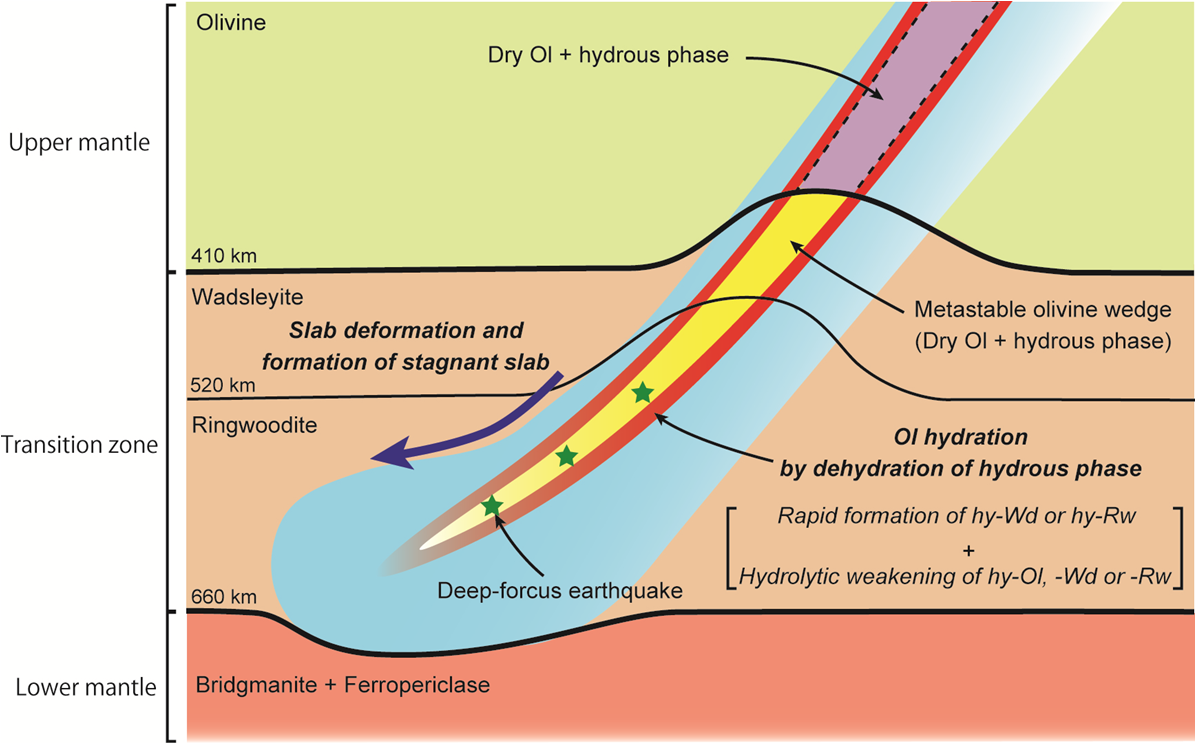Dry metastable olivine and slab deformation in a wet subducting slab - Dr. Takayuki Ishii
MAY 25, 2021
While the plates carry water to the Earth's interior, phase transitions of dry olivine, the main mineral in the plates, are thought to be responsible for deep-focus earthquakes and plate deformation. This study resolves the contradiction of the presence of dry olivine even in wet plates. Takayuki Ishii, a staff scientist of HPSTAR, and Eiji Otani, professor emeritus at Tohoku University, used high-pressure and high-temperature experiments to determine the water content of olivine under the conditions of a subducting plate containing water. The results show that the hydrous minerals absorb water, while the coexisting olivine contains no water at all. This experimental result overturned previous theories on the role of hydrous minerals, and revealed that deep-focus earthquakes can occur even in a wet plate, and that large plate deformation can also occur.The results of this research is published in Nature Geoscience.
The most widely accepted explanation for deep-focus earthquakes is that they are caused by the delayed transformation kinetics of dry olivine, which would seem to require that subducting slabs are dry. Metastable persistence of olivine to great depths (~630 km) leads to a wedge of olivine in the slab, and seismic observations of such wedges add weight to the proposed mechanism. However, in direct opposition to the dry wedge hypothesis, water is circulating not only at the Earth’s surface but also in the interior through subducting oceanic lithosphere: many geochemical and geophysical observations and mineral physics data indicate that ‘water’, in the form of hydroxyl groups, is present within both hydrous and nominally anhydrous minerals, implying that subducting slabs are hydrated. The presence of dry metastable olivine in wet subducting slabs is therefore paradoxical, and the hydration state of the slabs remains a topic of debate.Most previous studies focused on maximum solubility of water in olivine coexisting with hydrous melts outside the conditions where deep-focus earthquakes happen, under water-saturated conditions. However, natural wet subducting slabs may consist of olivine and hydrous minerals under water-undersaturated condition.
Here, they determined the water contents of olivine coexisting with hydrous phase A, a major dense hydrous magnesium silicate produced by dehydration of serpentine, under water-undersaturated conditions. They show that olivine is dry even under wet conditions. Alternately, a minor mineral of dense hydrous silicate preferentially crystallises as a host of water, which is the opposite conclusion to previous understanding of the water partitioning: olivine preferentially accommodates water and hydrous minerals forms when excess water exists. This finding changes our knowledge of the role of water in the deep Earth, implying that hydrous minerals play more important roles on water cycle in the Earth’s interior.
They thus solve the paradox: dry olivine experiences the delay transformation even in hydrated slabs, causing deep-focus earthquakes. Furthermore, this result suggests that dehydration of hydrous minerals, which is usually considered for an origin of intermediate-deep earthquakes, may also cause deep-focus earthquakes. Our finding also newly suggests a novel hypothesis that mysterious phenomena of slab bending and stagnation in the deep interior are caused jointly by dehydration of hydrous silicates and the subsequent rapid phase transformation of olivine enhanced by their released water, due to hydrolytic weakening of olivine and its high-pressure polymorphs.

Caption: Slab deformation and formation of a stagnant slab in a wet descending slab and their possible linkage with dehydration of hydrous phases.
人类发现深源地震至今已有90多年的历史,尽管科学家们采用高温高压实验模拟和理论计算等方法对其机制进行了众多研究,但至今依然众说纷纭,仍然是困扰地质科学家的一个未解之谜。近日,北京高压科学研究中心的Takayuki Ishii(石井)研究员的最新研究发现,深源地震是由俯冲含水片内部亚稳态橄榄石的相变引起的,并指出前人认为的深源地震是深俯冲无水板块引起的观点是存疑的。他们的研究解决了多年来关于深部俯冲带中是否存在橄榄石以及其中橄榄石的存在形式等诸多争议,帮助我们距离揭开深源地震的神秘面纱更近了一步。相关研究以“Dry metastable olivine and slab deformation in a wet subducting slab”为题于5月24日发表在Nature Geoscience上。
